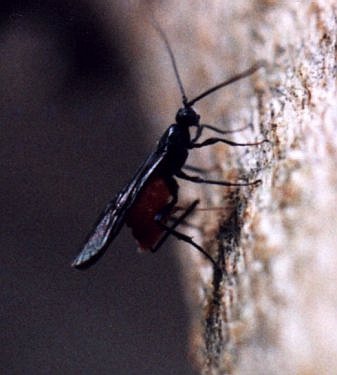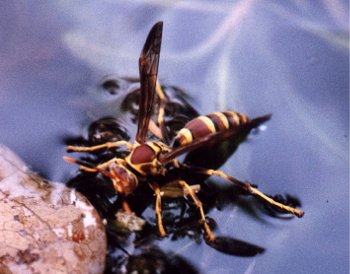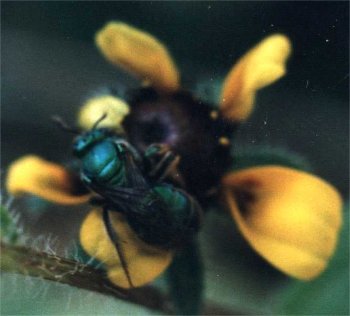Wasps
by Valerie (August 11, 2000)
In terms of behaviors, wasps are the stars of the insect world. They are fascinating, varied, and usually don't mind being watched as they play out their small dramas in the invertebrate world.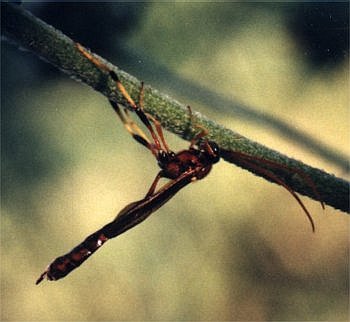
There are many different types of wasps and usually quite a few species of each type. I'm not as familiar with the smaller kinds, but can make a good guess as to which group they belong. I also don't have nearly as many photos of wasps as I have stories about their behavior, for two reasons. One is that I just don't have the camera handy when I see them doing something neat, and the other is that their movements are almost always very fast and jerky and I'm just not that fast with the focus, aperture, and shutter.
The picture above is of a solitary wasp and a perfect example of a thread-waist variety. Wasps either form colonies (like the paper wasps) or live alone, such as cicada killers. Most wasps are predators and a lot are parasitic. The solitary wasps often prey on spiders or parasitize other wasps or insects, and are in turn the victims of velvet ants (another type of wasp). Cicada killers are huge yellow and black wasps that are rather common around here, especially during the latter part of summer when the cicadas emerge. They make deep holes in the soil and paralyze a cicada, then carry it back to the hole where they deposit an egg. When the larva hatches, it has a huge insect to feed on until it reaches adulthood. I once heard a cicada call from a tree right over my head and when I looked up to find it, I saw a cicada killer fly directly into the spot from which the sound came. The cicada didn't make any more noise after that. I also watched a cicada killer drag a cicada up the trunk of a tree so that it could get enough height to be able to fly with such a heavy load.
Each wasp that preys on another insect or spider has to find one that is the appropriate size. When there are no cicadas, the cicada killer will use another insect, like a katydid. My mother-in-law told me about seeing huge wasps flying around a freshly delivered pile of soil in her yard. When I mentioned that they were probably cicada killers looking for the "perfect soil" for their nests, she said that explained all the immobile katydids they found when they were spreading the dirt. At the other end of the size spectrum, I watched a wasp less than ½ inch long work very hard to drag a little jumping spider that it had caught. It was too heavy for it to fly and it pulled the spider at least 10 feet to where it could get it up a tree. I happened to be sitting in the wasp's path, and it was scared off when I got up to move, but quickly came back and searched from the direction in which it was going until it found its prey again and resumed its journey. One more interesting episode about spider-hunting wasps: I saw a wasp flying around a large orb spider web, which appeared to be empty. The wasp kept hovering around the center, then followed one of the support threads to the branch to which it was attached. After searching around the branch, the wasp returned to the center of the web and followed a different thread to the leaf that was its anchor, and searched again. This continued until the wasp had checked every possible place which might have harbored the spider. However, the spider was not there, perhaps already having fallen victim to a previous predator.
The tiny wasp in the second photo is probably a type of gall wasp, a clue being the very long ovipositor that is visible in this picture. There are a lot of galls on our oak trees and these wasps are often in the vicinity. They fly rather slowly for a wasp, and have a very pretty red abdomen. Many gall wasps produce almost no males (I've never seen a male of this type - it would lack the ovipositor) and reproduce by parthenogenesis. Another small and strangely shaped wasp that frequents our yard is the ensign wasp (they sometimes live in the house as well). There are more than one species, but they are all very small and have short abdomens which they hold up in the air. The really nice thing about these wasps is that they parasitize cockroaches.
We have lots of paper wasps; they are the medium sized, black, brown and yellow wasps that are familiar to everyone. Their sting is not very potent and they do a wonderful job of keeping caterpillars in check. I've seen them devour half a caterpillar, then fly off with the remainder, presumably for their larvae back at the nest, since they don't store any food in the nest itself. They also spend a lot of time drinking in our ponds during very hot, dry periods, as the one in the photo is doing. They can land right on the water surface and not break the tension. I often see them flying around caterpillars' host plants, looking for prey. Another common wasp is the red wasp, often seen on flowers. These beautiful insects definitely have more punch in their sting, as I have found out from experience.
The colorful cuckoo wasp is common around flowers, feeding on pollen or nectar. I used to think that they were so named because of their resemblance to the iridescent green plumage of the African emerald cuckoo, but have since learned that it is their habit of parasitizing other wasps' nests in the manner of a European cuckoo that has resulted in their moniker. I was surprised once to find the head of one of these small wasps poking out of the end of a hollowed out stick.
Perhaps the most well-known, and gruesome, form of wasp parasitism occurs on the larvae of sphinx moths, or hornworms. A tiny kind of wasp will lay numerous eggs inside the body cavity of the growing caterpillar and the wasp larvae feed on the internal tissue without killing the insect, just causing it to continue to eat without metamorphosing. When the wasps are ready to create their cocoons and complete their life cycle, they emerge all over the back of the caterpillar to do so. The photo below shows the wasp larvae spinning their cocoons after emerging through the skin of the host. The caterpillar is doomed.
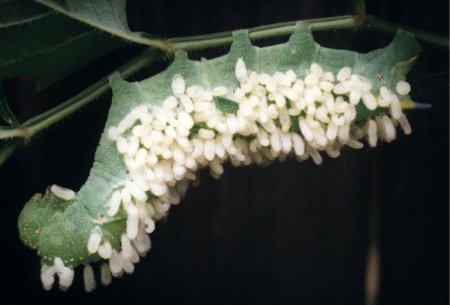
|
